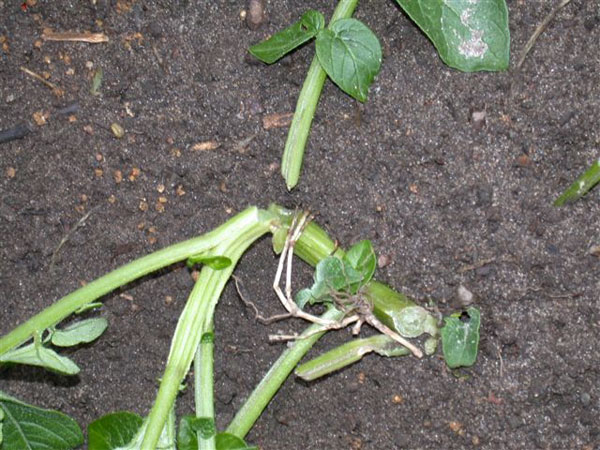Unbeknownst to the flourishing tomato plant, a silent foe lurks in the shadows, stealthily attacking the precious stems that serve as the plant’s lifeline. As the succulent greens wither and wilt, frustration ensues among gardeners who are left puzzled by the mystery of their beloved plant’s decline. In this article, we embark on a quest to unravel the enigma of “What is Eating My Tomato Plant Stems?” Delving into the depths of horticultural detective work, we aim to shed light on the culprits behind these voracious feasts, arming you with the knowledge to protect your tomato crop from further devastation. Ready your magnifying glass and join us as we embark on a journey through the intricate world of tomato stem assailants.
Identifying the Culprit: Common Pests and Diseases Affecting Tomato Plant Stems
Tomato growers often find themselves puzzled when they notice their precious plants’ stems being nibbled away. It can be disheartening to see the once vibrant and healthy stems damaged, but fear not, as we delve into the world of common pests and diseases that might be causing this mischief. Identifying the culprits is the first step towards finding the appropriate solution and rescuing your tomato plant.
One of the most common pests that can be found munching on tomato plant stems is the cutworm. These sneaky creatures are mostly active during the night and can be detected by their characteristic chomping marks on the stems. Another notorious offender is the tomato hornworm, a large green caterpillar that can cause significant damage to the stems by gnawing voraciously. However, it’s not all pest-related: fungal diseases like anthracnose and bacterial infections such as bacterial canker can also lead to stem deterioration. By identifying the specific symptoms and signs associated with these culprits, you can take targeted action to protect your tomato plants.
| Features | Tips |
|---|---|
| Physical barriers | Place collars or cardboard rings around the plant stems to prevent cutworms from gaining access. |
| Handpicking | Search for tomato hornworms carefully, manually removing them from the stems, keeping your plants safe. |
| Fungicide treatment | If fungal diseases like anthracnose are detected, apply a suitable fungicide as per the instructions. |
These are just a few examples of features and tips you can employ to protect your tomato plants from the culprits that seek to feast upon their precious stems. Remember, being proactive and attentive to your plants’ needs is the key to maintaining a healthy tomato patch throughout the growing season. Stay vigilant, and your tomatoes will thrive, undisturbed by those pesky stem-eaters!

Understanding the Signs: Symptoms and Damage Caused by Infestation or Infection
If you’ve noticed your tomato plant stems being eaten, it’s important to investigate the cause as soon as possible. Understanding the signs and symptoms of infestation or infection can help you identify the problem and take appropriate measures to protect your plants. Here are some common symptoms that may indicate an issue:
- Holes or Chewed Leaves: You may spot irregular holes or chunks missing from the leaves of your tomato plant. This could be a sign of pests, such as caterpillars or slugs, nibbling on the foliage.
- Wilting or Yellowing Leaves: If your tomato plant’s leaves appear wilting or turning yellow, it could indicate a fungal or bacterial infection, such as Fusarium wilt or bacterial spot. These diseases can weaken the plant and affect its overall health.
- Gnaw Marks on Stems: Look closely at the stems of your tomato plant for gnawing marks or chewed areas. This could be a sign of rodents, such as mice or rats, which can cause significant damage by feeding on the plant.
To identify the exact cause and find appropriate solutions, consider the following features or tips:
| Description | |
|---|---|
| Pest Control | Implement natural or chemical pest control methods, such as using beneficial insects, organic sprays, or traps, to manage pests that are damaging your tomato plant. |
| Pruning | Regularly prune the affected parts of the plant, such as damaged stems or leaves, to prevent further spread of fungal or bacterial infections. |
| Protective Barriers | Install protective barriers, such as wire mesh or fencing, around your tomato plants to deter rodents and other larger pests from accessing and damaging the stems. |
By understanding the signs, symptoms, and damage caused by infestation or infection, you can take proactive steps to safeguard your tomato plants and ensure a healthy harvest.

Taking Action: Effective Measures to Protect and Revitalize Tomato Plants
Are the stems of your tomato plants mysteriously disappearing? It can be quite disheartening to find your beloved plants being devoured by an unseen culprit. Fear not, for we have some effective measures that can help you identify and combat the pests responsible for munching on your tomato plant stems!
First off,
it’s important to investigate the potential pests that could be causing this damage. Look for common culprits such as hornworms, cutworms, or even rodents. These sneaky garden invaders can quickly destroy your tomato plants if left unchecked. To protect your precious tomatoes, consider these helpful tips:| Features | Tips |
|---|---|
| 1. Row Covers | 1. Covering your plants with row covers can provide a physical barrier against pests while still allowing sunlight and water to reach your tomato plants. |
| 2. Introduce Beneficial Insects | 2. Encouraging the presence of beneficial insects like ladybugs and lacewings can help control pest populations naturally, effectively protecting your tomato plants. |
| 3. Companion Planting | 3. Planting companion flowers such as marigolds or herbs like basil can repel pests and attract beneficial insects, creating a harmonious garden ecosystem. |
By implementing these measures and staying vigilant, you can protect and revitalize your tomato plants, ensuring a bountiful harvest. Remember, a little proactive action goes a long way in safeguarding the health and vitality of your garden!


